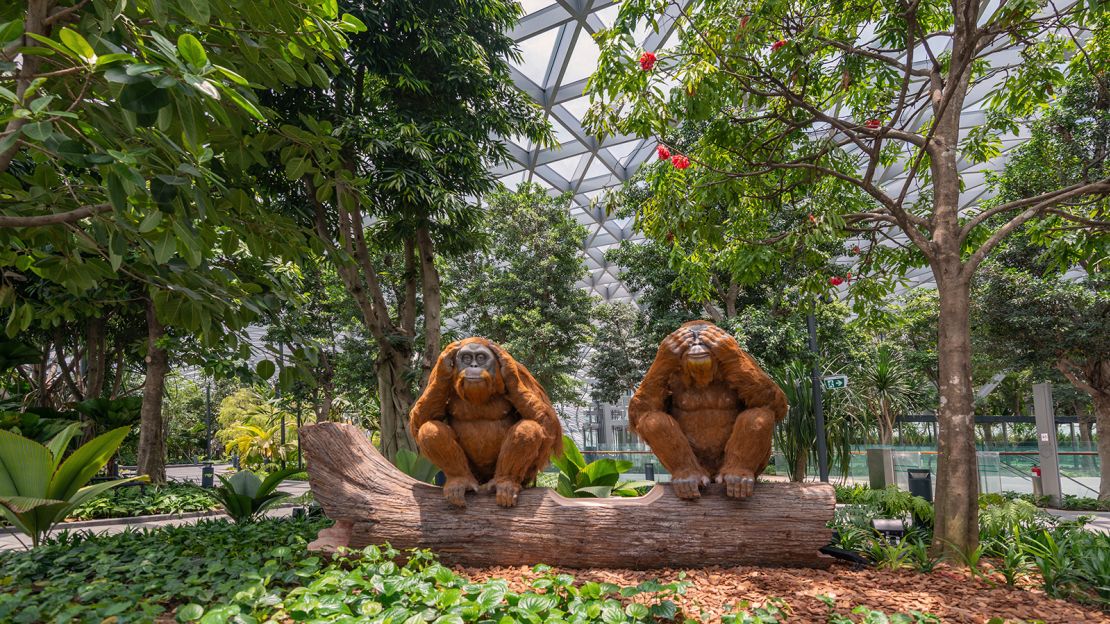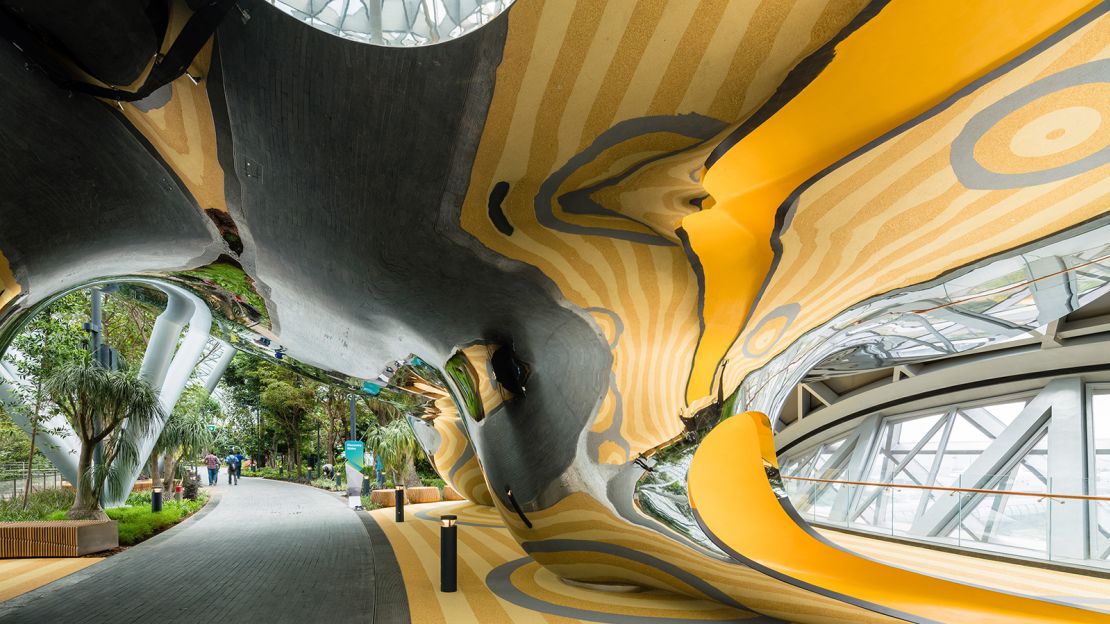Following four years of construction and nonstop media coverage, Singapore’s long-awaited Jewel Changi Airport is officially open.
Featuring a dramatic, doughnut-shaped exterior framed in steel and glass, the 135,700-square-meter space (around 1.46 million square feet) is a multi-use complex designed to connect three of Changi Airport’s four terminals.
But above all, the April 17 opening confirms long-held suspicions that yes, the “world’s best airport” is now even better and will likely hold onto its top spot on the Skytrax rankings, which it has dominated for the past seven years, for the foreseeable future.
Built at a cost of SG$1.7 billion (about US$1.25 billion) and designed by renowned architect Moshe Safdie, Jewel has 10 stories – five above ground and five in the basement.
The star attraction is the 40-meter-tall (around 130 feet) HSBC Rain Vortex, which cascades through a huge oculus in the middle of Jewel and is billed as the world’s tallest indoor waterfall.
It’s a dramatic site that’s usually heard before it’s seen as passengers exit the retail and dining zones that wrap around the Jewel’s outer sections and head toward the center, where they’re met with the thunderous sounds of a waterfall that appears to fall from the sky.
Take a photo tour of Changi Airport's new Jewel in Singapore
What exactly is the Jewel?
Containing over 280 retail and food/beverage outlets, Jewel Changi Airport could easily be written off as a beautiful shopping mall filled with dramatic green spaces that just happens to be connected to an airport.
After all, it’s not an airport terminal – there are no boarding gates or arrival halls, and anyone can visit.
But the new Changi addition serves multiple purposes for travelers. In addition to linking Terminals 1, 2 and 3 (passengers heading to and from Terminal 4 need to take a shuttle bus), offerings include early check-in services and baggage storage facilities as well as a 130-cabin YOTELAIR Singapore Changi Airport hotel.
There’s also the Changi Lounge, designed to complement a new intermodal transfer service that improves air-sea connectivity for cruise passengers.
Beyond expected amenities like free Wifi, Jewel offers a few little nice touches like power bank loans – free for 12 hours.

There are plenty of diversions for travelers stuck in Changi on a long layover, too, including an 11-cinema IMAX theater.
Jewel’s Shiseido Forest Valley is a four-story garden filled with walking trails set amid more than 235,000 square feet of landscaping, all surrounding the Vortex waterfall.
“Rainwater is collected and it becomes a part of the Vortex as well,” Jayson Goh, managing director for airport operations management of Changi Airport Group, tells CNN Travel.
“We can actually control the volume of flow. Below the Vortex we have tanks to collect the rainwater so that we can recycle it. When there’s an excess of rainwater, it can be used for irrigation of the plants in the Forest Valley.”
A Skytrain, which connects Changi terminals 1, 2 and 3, cuts through the middle of the Jewel, passing by the Vortex and adding to the photogenic scene.
On the top floor is the 14,000-square-meter Canopy Park, which has several restaurants and themed gardens. Though some sections are open, work is still underway on this one. The park’s Canopy Mazes, Sky Nets, Discovery Slides and 50-meter Canopy Bridge won’t be ready until mid-2019.
From parking lot to architectural paradise

The back story behind Jewel’s development is basically Joni Mitchell’s “Big Yellow Taxi” in reverse. Changi Airport Group has essentially turned a parking lot into an indoor paradise, inspired by Singapore’s reputation as a “city in a garden.”
“Back in 2010 we were looking at expanding the capacity of Terminal 1 and we decided that the open-air parking structure could potentially become a new integrated complex,” says Goh.
That car park was transformed into the stunning space that now stands in its place, a marvel for those who have been following Jewel Changi Airport’s progress since 2013, when news of the airport expansion – then simply named “Project Jewel” – first broke.
Given that the architect behind the project is Moshe Safdie, at the time already famous for designing another Singapore icon, Marina Bay Sands, hopes were high that he would deliver an equally impactful building.
“I wanted to explore a new kind of urban space, a space you go to as a matter of course, because you need to shop, because you’re flying out somewhere, and yet it’s a garden – somewhere that says ‘let’s rethink what the public realm is, let’s rethink what it is to shop,’” Safdie told CNN Travel last year.
“I think one of the reasons [we won] the bid was that the other submissions looked like malls and felt like malls, while this one, you don’t think of it as a mall, because it’s a new kind of experience. It makes us rethink what urban centers could be like if we stretch our thinking.”
A space for locals, too

In most cities, a trip to the airport is not something people would consider “fun,” beyond the excitement of knowing you’re boarding a plane to go on a holiday or pick up a loved one.
In Singapore, however, the airport is just 30 minutes or less from the central business district, making it feasible that locals will actually head there for a meal or to take in a movie on a regular basis.
The Changi Airport Group is banking on this, with multiple executives saying they expect it to be a popular spot among Singapore residents.
“I think the opening of Jewel does create a lot of excitement amongst local residents as well, and we’ll try our best to deepen this,” says Goh.
“Singapore’s a small place and therefore we do get a lot of local residents coming to the airport to spend their weekends here. We have people coming here to study, we have people coming here on dates. In fact, we always get requests from local residents who want to take wedding photos.”
In terms of offerings that might entice locals, Jewel has a few Singapore firsts in its food and beverage and retail offerings. These include US burger chain Shake Shack, the UK’s Lobster & Burger and the world’s first Pokemon Center outside of Japan.
What’s next for Changi?
Keeping the “world’s best airport” ahead of the competition means there’s no time to sit around and bask in the aquatic glow of the Vortex as thousands of visitors begin to flood Jewel’s spaces.
Changi Airport is currently the world’s seventh busiest airport for international traffic, with a record 65.6 million passengers passing through its four terminals in 2018, according to the most recent airport figures.
It connects to over 400 cities globally and serves more than 100 airlines, with a plane taking off or landing every 80 seconds.
According to the airport’s data, passenger numbers have almost doubled in 10 years, hence the constant focus on growth.
Planning for a massive Terminal 5 – which will be about the size of all four terminals put together – is now underway, with the facility expected to open after 2030.
Beginning later this year, Singapore’s Changi Airport Terminal 2 is set to undergo a five-year expansion project that will include an overhaul of the departure check-in hall and transit area.
“With the addition of the new capacity in Terminal 2, that will bring the overall passenger capacity of Changi airport to 90 million passengers per annum, and with Terminal 5, we have current plans to add another 50 million passenger-per-annum capacity,” says Goh.
“So, by 2030, if everything goes according to plan, we’ll have a total of about 140 million passenger-per-annum capacity at Changi.”














































